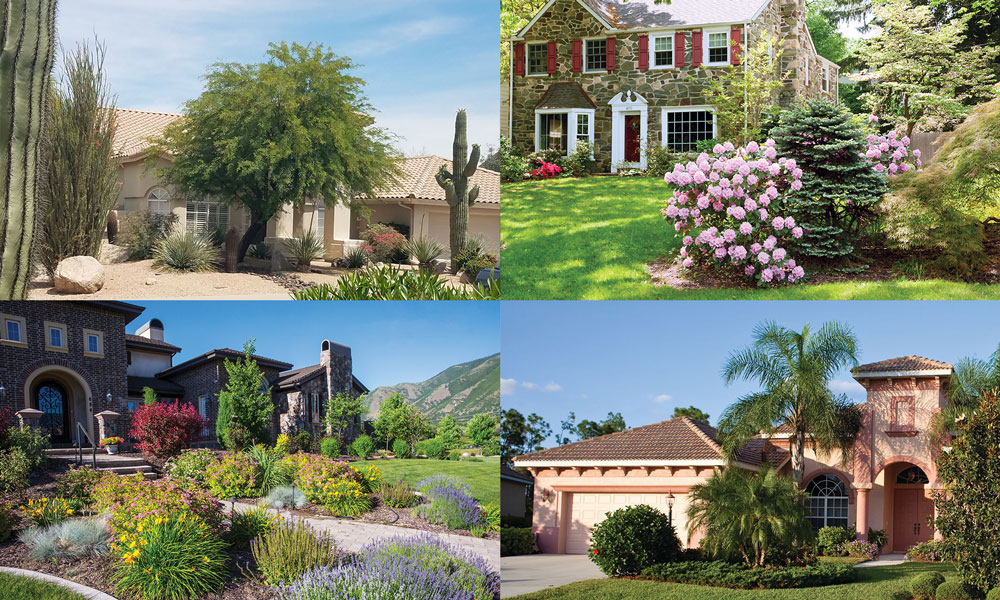SavATree specializes in servicing all types of trees, including the most common tree varieties found in the US. Your SavATree certified arborist is equipped with the latest techniques and state-of-the-art equipment to keep your trees healthy, beautiful and safe. If you would like to discuss what tree varieties are suitable for your landscape or have general health and maintenance concerns, contact a location nearest you.
Apple Trees

Spring flowers, summer shade and delicious fruit are just some of the wonderful benefits of owning an apple tree. These trees prefer dry, warm climates and moist, loamy soil. Fruit is produced by the pollination of the tree’s flowers. Because many apple trees do not self-pollinate, a variety of apple trees that bloom at the same time need to be planted to encourage self-pollination and fruit production. An apple tree will usually bear fruit in its fourth or fifth year. Fruit comes in many sizes and colors and is best eaten right off the tree.
Arborvitae Trees
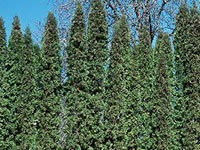
A dense, narrow, evergreen shrub or small tree, arborvitae makes a wonderful privacy screen and windbreak. The shape of an arborvitae tree varies depending on cultivar. An American arborvitae tree is full and cone shaped. The Globe arborvitae tree is broad and spherical while the Pyramidal arborvitae is a taller, thinner variety.
Arborvitae can also be pruned into various ornamental hedges or grown in containers. They are however, a favorite delicacy of deer.
Ash Trees
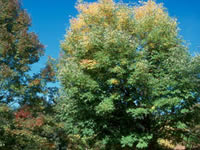
The ash tree is a handsome, native, deciduous tree. There are over 60 ash tree species— the white ash being the largest of the family.
The ash tree is a strong, medium to very large tree, depending on type, and a relative of the olive tree. Ash trees have an opposite branching structure, with multiple leaflets. Depending on species, ash tree leaves are green, turning yellow or purple-burgundy in the fall. Spring flowers are inconspicuous, but the fruit that follows is more noticeable, hanging in clusters of winged seeds which turn light brown and linger on the tree until early winter. The ash tree has a lovely rounded crown and gray diamond-shaped furrowed trunk when mature. An interesting fact about the ash tree is its characteristic agile wood is used to make baseball bats.
Birch Trees
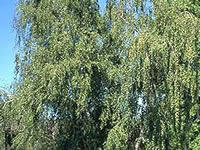
The birch tree is popular among homeowners due to its beautiful bark, modest size and graceful branches. Two of the most common birch tree species in the Northeast are the River Birch and White Birch. The White Birch tree is characterized by its beautiful white bark (when mature) and drooping branches, whereas the River Birch tree has a brownish-red exfoliating bark and pyramidal to rounded crown. These characteristic bark qualities provide interest in the landscape throughout all four seasons. A birch tree’s leaves are green with sharp edges, which turn yellow in the fall depending on the species.
Cherry Trees
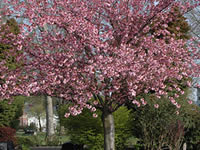
In addition to their wonderful fruit, many property owners grow cherry trees for their spectacular spring flowers. Cherry trees can have a graceful weeping form or attractive upright canopy depending on the species. There are many cherry tree varieties to choose from. Most cherries produce pink to white flowers. Cherry tree leaves are also attractive in the fall.
Common Persimmon Trees
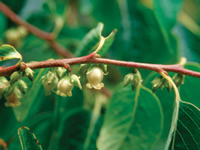
The common persimmon (Diospyros virginiana) is a deciduous tree that is grown for its beautiful foliage and edible fruit, and it is prized for its beauty and wood density.
A common persimmon in the landscape averages around 60 feet tall and in its natural environment can be found as large as 132 feet tall.
Dogwood Trees
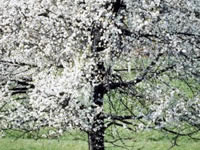
The flowering dogwood tree is a favorite ornamental among homeowners due to its year round appeal, unique branching structure and modest size. In the early spring, beautiful flowers bloom consisting of four white, pink or red bracts with clusters of small yellow flowers in the center. In fall, leaves and fruit are a stunning bright red/purple. Winter interest includes the presence of large flattened buds accented by a dark gray, brown or black alligator-skin like bark. Dogwood trees are certainly a lovely landscape specimen.
Elm Trees

The stately elm tree is a beloved American treasure. The elm tree’s large, broad canopy and interweaved drooping branches grace the streets of many towns and landscapes.
The elm is a deciduous tree with large 6 inch, dark green leaves that turn yellow in the fall. In the spring the elm tree has dense clusters of small, green flowers that blossom.
Japanese Maple Trees
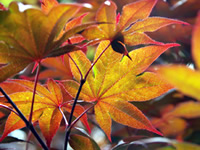
Japanese maple trees (Acer palmatum) are perhaps one of the most vibrant and familiar trees in the Northeast. Their spectacular seasonal color, leaf variation, diverse shape, size and texture add richness to many landscapes. Due to their versatility and range of characteristics, one doesn’t have to look far to find a Japanese maple tree to fit their landscape needs. With proper selection and regular tree service, Japanese maple trees can flourish in various settings including sun, shade; in gardens, containers and bonsai.
Leyland Cypress Trees
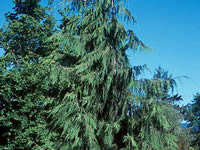
The Leyland Cypress tree is a stately, pyramid-shaped evergreen. It has a rapid growth rate (3 feet or more per year) and dense structure, making it ideal for use in privacy screens, windbreaks and hedges, and is used for Christmas tree production in some parts of the country.
A single Leyland Cypress tree is also an impressive addition to the landscape. It has feathery, soft pointed needles arranged in flat sprays on long thin branches. Needles retain their rich color year round, starting out green in youth and turning a dark bluish-green hue as they mature. The tree’s needles release a pleasant fragrance when broken.
Lilac Trees
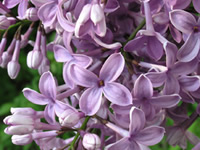
A sure sign that the warm days of spring are upon us is the bloom of the Lilac tree (Syringa species). Their colorful clusters of flowers and magnificent fragrance make the lilac tree a favorite shrub among arborists, gardeners, tree service experts and even non-gardeners. There are over 20 species with 1,000 lilac tree varieties alone. Different varieties of lilac trees can have blossoms that are pink, purple or white.
They bloom for almost two weeks, primarily during May. After the blooms are gone, the green, heart shaped leaves continue to add depth and character to the landscape. You can extend the display of lilac tree flowers for as much as six weeks, by planting different lilac tree varieties.
Maple Trees
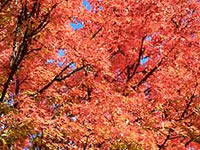
There are approximately 125 different maple tree varieties. Maple trees are popular in the northern regions of the United States. Maples are deciduous trees, characterized by opposite leaf arrangement and spectacular fall color. Their flowers are upright and green, yellow or red in color depending on species. Fruit appears in winged clusters which hold the seeds of the lovely, self-pollinating maple tree.
Oak Trees

A noble American tree, oak trees are found in many landscapes and communities, adorning us with their stature and shade. There are nearly 400 different species of oaks, both deciduous and evergreen. Some of the most common species found in the Northeast include the Red Oak, White Oak and Black Oak.
Depending on the species, oak trees can have gray, scaly bark or black furrowed bark. Leaves are typically green and can be serrated or rounded, turning red in the fall. The yellowish-brown flower of the oak tree is produced in the spring and is called a catkin. Acorns are the fruit housing the seed which is enjoyed by squirrels and other wildlife.
Plum Trees
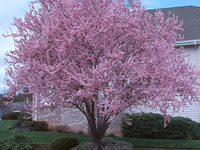
The purple-leaved plum tree is a dramatic ornamental tree. It is usually selected for its abundant and stunning display of pink flowers and lush reddish-purple leaves. It is particularly showy because flowers bloom early in the spring before foliage appears. The plum tree’s richly colored leaves are 1-1/2 to 3 inches long and are present throughout most of the growing season, making a lovely contrast and enhancement to the landscape.
Some people do opt to purchase the fruit bearing variety, which produces small purple plums. A fast grower, the plum tree has an upright form with a lovely rounded and dense canopy. For best results, tree should be positioned in full sun and well-drained, acidic soil.
Pine Trees
Pine trees are softwood evergreens that can grow in compact groupings, making them ideal for use as a screen or windbreak. There are about 110 species of pine trees, with many color variations among species. The Eastern White pine, for example, has bluish needles in groups of five. Most pine trees have a pyramid shape when young, but become a freer formed canopy as the tree matures. Pine tree cones are typically grouped in the top third of the tree, maturing at different levels based on species. Cones are the fingerprints of pine trees with no two species having identical cones. Several species of pine trees are used in large landscapes, parks and as Christmas trees.
Sycamore Trees
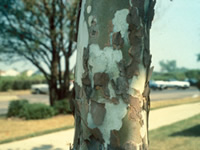
The sycamore tree is an immense durable tree with a rapid growth rate and expansive root system. It has an upright, pyramidal crown when young and as it matures develops a rounded, irregular form, with a scaffold of large diameter branches. The most unique feature of the sycamore tree is its camouflage-looking bark. The outer bark is unable to grow at the same rate as the trunk and limbs thus shedding its skin. The bark peels off in blotches revealing the white, tan and green inner bark. It has large 4″ – 10″ wide thick green leaves resembling those of maples and fruit is round, fuzzy and brown.
White Oak Trees
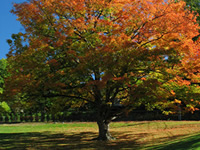
Any Northeast property that has tree life is likely to have a specimen of the ubiquitous and noteworthy white oak tree (quercus alba). This variety of oak tree sometimes lives for over six hundred years. In the wild white oak trees are known to grow very tall with enormous branches sticking out at broad angles. Despite its name, the white oak tree is characterized by a grayish and scaly bark marked with shallow rivets. In general, a mature white oak tree will range from 85-100 feet. Oftentimes its large width is equal to its height.
Willow Trees
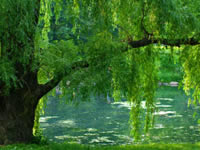
The majestic, graceful willow tree is often found by a pond, stream or other body of water. While it prefers moist soil, weeping willows can do well in drier areas as long as watered regularly. Willow trees require a lot of room due to their size which includes a massive root system and sweeping round crown. This deciduous tree has green narrow leaves and yellow flowers that bloom during April and May. Willow trees are fast growing trees that add drama and shade to large landscapes.





